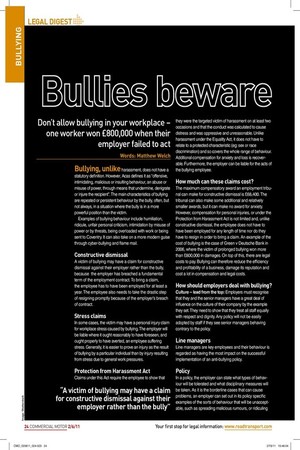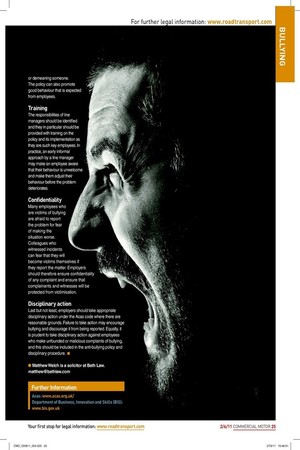Don’t allow bullying in your workplace – one worker won £800,000 when their employer failed to act
Page 21

Page 22

If you've noticed an error in this article please click here to report it so we can fix it.
Words: Matthew Welch Bullying, unlike harassment, does not have a statutory definition. However, Acas defines it as “offensive, intimidating, malicious or insulting behaviour, an abuse or misuse of power, through means that undermine, denigrate or injure the recipient”. The main characteristics of bullying are repeated or persistent behaviour by the bully, often, but not always, in a situation where the bully is in a more powerful position than the victim.
Examples of bullying behaviour include humiliation, ridicule, unfair personal criticism, intimidation by misuse of power or by threats, being overloaded with work or being sent to Coventry. It can also take on a more modern guise through cyber-bullying and flame mail.
Constructive dismissal
A victim of bullying may have a claim for constructive dismissal against their employer rather than the bully, because the employer has breached a fundamental term of the employment contract. To bring a claim, the employee has to have been employed for at least a year. The employee also needs to take the drastic step of resigning promptly because of the employer’s breach of contract.
Stress claims
In some cases, the victim may have a personal injury claim for workplace stress caused by bullying. The employer will be liable where it ought reasonably to have foreseen, and ought properly to have averted, an employee suffering stress. Generally, it is easier to prove an injury as the result of bullying by a particular individual than by injury resulting from stress due to general work pressures.
Protection from Harassment Act
Claims under this Act require the employee to show that
“A victim of bullying may have a claim for constructive dismissal against their employer rather than the bully”
they were the targeted victim of harassment on at least two occasions and that the conduct was calculated to cause distress and was oppressive and unreasonable. Unlike harassment under the Equality Act, it does not have to relate to a protected characteristic (eg: sex or race discrimination) and so covers the whole range of behaviour. Additional compensation for anxiety and loss is recoverable. Furthermore, the employer can be liable for the acts of the bullying employee.
How much can these claims cost?
The maximum compensatory award an employment tribunal can make for constructive dismissal is £68,400. The tribunal can also make some additional and relatively smaller awards, but it can make no award for anxiety. However, compensation for personal injuries, or under the Protection from Harassment Act is not limited and, unlike constructive dismissal, the employee does not have to have been employed for any length of time nor do they have to resign in order to bring a claim. An example of the cost of bullying is the case of Green v Deutsche Bank in 2006, where the victim of prolonged bullying won more than £800,000 in damages. On top of this, there are legal costs to pay. Bullying can therefore reduce the efficiency and profitability of a business, damage its reputation and cost a lot in compensation and legal costs.
How should employers deal with bullying?
Culture – lead from the top: Employers must recognise that they and the senior managers have a great deal of influence on the culture of their company by the example they set. They need to show that they treat all staff equally with respect and dignity. Any policy will not be easily adopted by staff if they see senior managers behaving contrary to the policy.
Line managers
Line managers are key employees and their behaviour is regarded as having the most impact on the successful implementation of an anti-bullying policy.
Policy
In a policy, the employer can state what types of behaviour will be tolerated and what disciplinary measures will be taken. As it is the borderline cases that can cause problems, an employer can set out in its policy specific examples of the sorts of behaviour that will be unacceptable, such as spreading malicious rumours, or ridiculing or demeaning someone. The policy can also promote good behaviour that is expected from employees.
Training
The responsibilities of line managers should be identified and they in particular should be provided with training on the policy and its implementation as they are such key employees. In practice, an early informal approach by a line manager may make an employee aware that their behaviour is unwelcome and make them adjust their behaviour before the problem deteriorates.
Confidentiality
Many employees who are victims of bullying are afraid to report the problem for fear of making the situation worse.
Colleagues who witnessed incidents can fear that they will become victims themselves if they report the matter. Employers should therefore ensure confidentiality of any complaint and ensure that complainants and witnesses will be protected from victimisation.
Disciplinary action
Last but not least, employers should take appropriate disciplinary action under the Acas code where there are reasonable grounds. Failure to take action may encourage bullying and discourage it from being reported. Equally, it is prudent to take disciplinary action against employees who make unfounded or malicious complaints of bullying, and this should be included in the anti-bullying policy and disciplinary procedure. ■














































